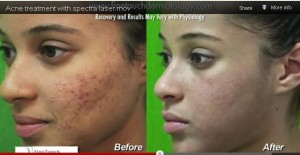Severe acne flare-ups and breakouts, coupled with the accompanying inflammation, result in acne scars. Scars resemble small “craters” made of scar tissue, which differs in appearance and consistency than surrounding skin. Since the body treats severe acne as an injury to the skin, repairing the damage involves the wound healing process.
THE WOUND HEALING PROCESS
The wound healing process is classically divided into hemostasis, inflammation, proliferation and remodeling. A more contemporary model breaks it down to the early phase and cellular phase. Regardless of cause, response to injury creates an exaggerated healing response.
Resident immune and repair cells around the acne breakout become conditionally deficient in energy. This then triggers the inflammatory cascade and recruitment of circulating peripheral cells to rapidly repair the injury. However, the wound healing process’ main goal is re-establishing continuity without regards to exact replacement of lost/damaged tissue.
The inflammatory phase also recruits and activates fibroblasts. The cells synthesize the extracellular matrix and collagen. During remodeling of the injury, however, the rate of degradation of the extracellular matrix is slower than the stimulation of collagen formation. This leads to an improper intracellular matrix, which results in adhesions, fibrosis and scar tissue.
The alignment of collagen on the injury is what creates scarring. In normal skin, collagen fibers are arranged in basket-weave patterns; in scarred skin, collagen fibers align. Scarred skin may differ in color and is less resistant to UV rays. Additionally, hair follicles do not grow through scars.
TYPES OF ACNE SCARS
Acne scars are classified into the following four categories:
- Hypertrophic scars: Red and raised from skin’s surface; similar to keloid scars
- Box Car Scars: Angular shape; similar to chicken pox scars; occur on temples and cheeks
- Ice Pick Scars: Indented pits in the skin’s surface
- Rolling Scars: Wave-like appearance; bands form between skin layers
SCAR TREATMENTS AVAILABLE IN LOS ANGELES
The fibrillar arrangement of collagen molecules into cross-wover microfibrils during collagen allows for greater stability in healing tissue. However, this arrangement also makes scarring permanent. Though acnes scars may minimize slightly over time, severe scarring requires dermatologic treatments. Specific methods target reducing recession and pit depth, as well as improving the skin’s texture.
Dermabrasion
Dermabrasion entails sanding the skin at varying pressures and speeds. Either an electromechanical device or a manual tool is used with a diamond fraise or textured metallic surface. The top skin layer is excoriated, leaving the treated skin area rather bloody.
Downtime is significant following the procedure, with potential scarring and skin discoloration complications. However, dermabrasion’s aggressive approach makes it very effective to treat severe acne. Dermabrasion is not advised for those with dark complexions due to the potential for permanent skin discoloration.
Microdermabrasion
Microdermabrasion also sands the skin’s surface but is much less aggressive than dermabrasion. Microscopic particles are blasted onto the skin, such as finely ground magnesium salt crystals. It removes the skin’s outer layer, which allows new cell surfacing. However, microdermabraision does not dramatically improve severe acne scars because of its milder approach.
Punch graft surgery
Scar tissue is surgically with a small tool and replaced with a skin graft. The donor area for the graft is typically behind the ear to ensure a smooth surface. Punch graft surgery is invasive and requires significant downtime. Once the treated area heals, microdermabrasion and chemical peels may alleviate any irregularities that remain.
Fraxel For Acne Scars
1. Fraxel re:pair SST:
Fraxel r:epair SST uses a fractionated CO2 laser. It is an ablative treatment that vaporizes scar tissue, which may improve acne scars after one treatment. The resulting new skin fills in scar depression. Downtime ranges between one and two weeks. Treatment is only recommended for those with lighter skin.
2. Fraxel Dual 1550/1927:
Fraxel Dual is a non-ablative treatment that induces collagen remodeling. It targets deeper layers of the dermis with the Erbium fiber component of the laser, which uses a 1,550-nanometer wavelength to normalize the collagen density. To refine the skin, the 1,927-nanometer Thulium fiber component is used. The precision of the laser allows targeted treatments, and significant improvements occur after one treatment.
Laser skin treatments have improved significantly, giving patients more options to address acne and its resulting scaring with less downtime. Dr. Sanusi Umar and his Los Angeles clinic have helped numerous patients eradicate severe acne scarring.

